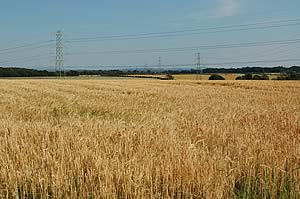| 12/08/07
The heavy rains which have swept across large portions
of the British Isles this summer are bringing a significantly
increased risk of mould and toxin contamination to grain
farmers and feed manufacturers, according to agricultural
specialists Agil.
 |
In France, where similar rainfall occurred there has been
a surge in sales of toxin binders such as Sorbatox which
traps the mycotoxins. These mycotoxins are produced under
damp conditions both in the standing crop and in storage.
Latest Met Office figures for the UK have shown that the
last three months have been the wettest on record. England
and Wales have seen the wettest May - July period since
records began with around 390mm more than twice the national
average. All regions have seen record rainfall and all
except South East England, North West England and North
Wales have seen over twice their average rainfall. The
worst hit area is the Central England region which has
seen 226 per cent of average rain.
“After a wet summer like this with poor harvest conditions,
moulds such as Fusarium and Aspergillus can be found on
standing crops,” says Murray Hyden, managing director
of Agil. “If not treated these moulds can seriously
impact on yields, profits and animal health.”
Fusarium is recognised in the field by the premature bleaching
of infected spikelets and the production of orange spore-bearing
structures called sporodochia at the base of the glumes.
During wet weather, this is likely to take the form of
white / pinkish, fluffy fungal growth on infected heads
in the field.
The Aspergillus mould, along with Fusarium, is one of
the main producers of mycotoxins including Aflatoxin a
naturally occurring mycotoxin. The production of Alflatoxin
also increases in wet summers and is helped by moderately
high temperatures too. Fungal growth in standing crops
result in a dull, grey appearance rather than the more
typical bright golden coloured fields at harvest.
“There are a number of options open to farmers to
inhibit and combat mould and toxins,” explained Mr
Hyden. “Mycostat and other effective anti-mould inhibitors
which are based on propionic, acetic and sorbic acid combined
with their ammonium salts can prevent new mould colonising
and existing moulds from growing and producing toxins in
the stored grains.”
“Working alongside these mould inhibitors, many farmers
also use toxin binders such as Sorbatox which work very
effectively in the aqueous environment of the animal intestine.
These binders, which have a high level of aluminium silicate,
provide a large number of sites within the mineral to attract
and hold secure the particularly dangerous varieties of
mycotoxins. These toxins are then excreted naturally without
being absorbed into the intestinal tract and impacting
on feed conversion and fertility”
 Farmer Gets Lost in His Own Maize Maze Farmer Gets Lost in His Own Maize Maze
 Grain Treatment Cuts Drying Costs and Boosts Feed Value Grain Treatment Cuts Drying Costs and Boosts Feed Value
 Biofuels = More Livestock Feed Biofuels = More Livestock Feed
 Reducing the Impact of Increasing Pig Feed Costs Reducing the Impact of Increasing Pig Feed Costs
|


